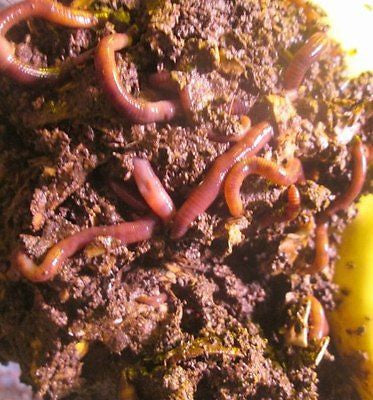Red wigglers: Make composting fun
Red wigglers: Make composting fun
Blog Article
Why Red Wigglers Are the Finest Choice for Your Composting Needs
Red wigglers have become a remarkable choice for composting due to their impressive ability to effectively decay organic matter while producing high-grade worm castings. Their versatility to numerous settings allows for versatile applications, making them suitable for both city and country composting arrangements. In addition, the nutrient account of their castings significantly benefits soil wellness, promoting sustainable gardening practices. The trip to effective vermicomposting includes more than just acquiring these worms, and comprehending the ideal conditions and false impressions bordering them is crucial for maximizing their possibility.
Benefits of Red Wigglers

Red wigglers thrive in a selection of conditions, making them adaptable to various composting arrangements, from little bins to bigger systems. They master vermicomposting, where their task develops a high-quality final result called worm castings, abundant in beneficial microorganisms and nutrients important for plant development. This all-natural fertilizer advertises dirt health, improves dampness retention, and enhances plant durability against parasites and diseases.
Additionally, using red wigglers can significantly lower methane discharges connected with landfill waste, adding to environmental sustainability. Their convenience of care and very little maintenance demands make them appropriate for both newbie and skilled composters. Ultimately, integrating red wigglers into your composting strategy not only fosters efficient waste administration however likewise raises the quality of your compost.
Ideal Composting Problems
Producing optimal composting conditions is important for maximizing the efficiency of red wigglers in breaking down natural issue. These worms prosper in a regulated setting that mimics their all-natural environment, which mainly includes wet, dark, and well-aerated rooms. To achieve this, keeping a temperature level array of 55 ° F to 77 ° F is crucial, as severe temperature levels can prevent their task and even result in mortality.
(red wigglers)Moisture levels must additionally be very carefully checked; red wigglers require a wet atmosphere, preferably around 70% dampness content. Way too much wetness can bring about anaerobic conditions, while inadequate moisture can create dehydration. In addition, a well balanced carbon-to-nitrogen ratio, ideally around 25:1 to 30:1, sustains optimum digestion and nutrient biking.
In addition, the composting medium should be kept loosened and oxygenated, enabling for correct airflow. This not only benefits the worms however also aids in the break down of natural materials. By making certain these optimal problems, composters can develop a flourishing ecological community that improves the effectiveness of red wigglers, ultimately bring about rich, nutrient-dense garden compost.
How to Beginning Vermicomposting
Starting vermicomposting is an uncomplicated process that can produce significant benefits for both your garden and the environment. To start, pick an appropriate container, such as a plastic bin or a wood box, guaranteeing it has ventilation openings for air movement. A dimension of approximately 15 to 20 gallons is optimal for small-scale procedures.
Next, prepare the bed linen product, which need to be a combination of shredded paper, cardboard, and coconut coir. This bedding supplies a comfortable habitat for the worms while keeping moisture. Purpose for a bed linen depth of about 4 to 6 inches.
When the bed linen is recommended you read ready, introduce red wigglers into the container. A populace of about 1,000 worms is adequate for processing kitchen area scraps properly. After including the worms, incorporate a well balanced mix of eco-friendly products, such as fruit and vegetable scraps, together with brown products, like dried fallen leaves.

Nutrient-Rich Castings
(red wiggler composting worms)The red wigglers in your vermicomposting system play an important duty in producing nutrient-rich spreadings, a highly desired organic plant food. These castings, frequently referred to as worm humus, are the result of the worms digesting raw material and eliminating it in a form that is incredibly useful for plants.
Rich in essential nutrients such as nitrogen, phosphorus, and potassium, worm spreadings give a well balanced resource of fertility that enhances dirt framework and advertises healthy and balanced plant growth. Additionally, they consist of useful bacteria that further improve soil wellness, helping in nutrient absorption and disease resistance.
The slow-release nature of worm castings makes certain that nutrients are readily available to plants over an extensive duration, lowering the threat of nutrient leaching and hence adding to sustainable gardening techniques. Unlike synthetic plant foods, which can bring about soil destruction in time, worm castings enhance the soil's physical, chemical, and biological properties.
Consequently, incorporating red wigglers into your composting efforts not just mitigates waste however additionally produces a premium natural change that considerably benefits gardens, landscapes, and potted plants alike. - red wigglers
Typical Mistaken Beliefs About Worms
While many individuals acknowledge the benefits of making use of worms in composting, a number of misconceptions persist concerning their biology and behavior. One typical myth is that all worms are just as efficient for composting, when as a matter of fact, only particular types, like red wigglers, thrive in natural waste environments. These worms are particularly adapted to composting, making them perfect for this function.
An additional false impression is that worms are delicate and call for overly certain problems to survive. In fact, red wigglers are quite durable, able to endure a variety of temperatures and wetness degrees, provided they are kept within an appropriate array.
Additionally, some believe that worms eat all kinds of food waste indiscriminately. Red wigglers like specific organic materials, such as fruit and veggie scraps, and can battle with meat, milk, and oily foods, which can develop smells and bring in pests.
Final Thought
In verdict, red wigglers represent an optimal selection for composting due to their fast decomposition capacities and flexibility to various atmospheres. Comprehending the ideal conditions for vermicomposting and attending to common misconceptions regarding these worms even more solidifies their duty in effective waste administration.
Report this page